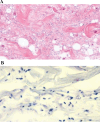Gas gangrene with Clostridium septicum in a neutropenic patient
- PMID: 39373951
- PMCID: PMC11971146
- DOI: 10.1007/s15010-024-02401-y
Gas gangrene with Clostridium septicum in a neutropenic patient
Abstract
Gas gangrene is a rare presentation of a necrotizing fasciitis, caused by Clostridium perfringens, C. septicum and other clostridial species. With its rapid progression it is a potentially life-threatening infection, that poses as a challenge in the clinical management requiring an interdisciplinary approach.Here we present a 62-year-old woman, who developed neutropenic fever while undergoing chemotherapy for triple negative breast cancer. She presented with a high fever, reporting little pain in her left thigh accompanied by redness and induration locally. Subsequently the patient developed pain and redness of the back of the left hand. The initial findings suggested cellulitis and immediate empiric treatment with intravenous meropenem was started. Despite the antibiotic treatment the patient rapidly developed septic shock along with progression of the local infection. Emergency surgical debridement revealed extensive necrosis of the soft tissues including extensive myonecrosis of the thigh. On the left hand an extensive debridement was performed, the left lower limb could not be preserved and exarticulation of the left hip was required. Microbiologically C. septicum was isolated in different samples, confirming gas gangrene. As there was no local entry portal on the skin, hematogenous seeding from intestinal translocation in this neutropenic patient was suspected. The empiric antibiotic treatment was tailored to intravenous penicillin and complemented with clindamycin for toxin inhibition. Following radical debridement and antibiotic treatment, the patient could be stabilized. After repetitive debridement wound closure was achieved and the patient was discharged for rehabilitation. Antibiotic treatment was continued for four weeks.This rare case of gas gangrene in a neutropenic patient shows the complexity in the diagnostic and therapeutic management of necrotizing soft tissue infections in immunocompromised patients. It particularly highlights the importance of an interdisciplinary management with fast recognition of the disease and rapid, if needed radical, surgical debridement as well as tailored antibiotic treatment for a successful outcome.
© 2024. The Author(s).
Conflict of interest statement
Declarations. Informed consent: Statement: Informed consent was obtained from all subjects involved in the case report. Written informed consent has been obtained from the patient to publish this paper. Competing interests: The authors declare no competing interests.
Figures





References
-
- Srivastava I, Aldape MJ, Bryant AE, Stevens DL, Spontaneous C. Septicum gas gangrene: a literature review. Anaerobe. 2017;48:165–71. 10.1016/j.anaerobe.2017.07.008. - PubMed
-
- Naamany E, Shiber S, Duskin-Bitan H, Yahav D, Bishara J, Sagy I, et al. Polymicrobial and monomicrobial necrotizing soft tissue infections: comparison of clinical, laboratory, radiological, and pathological hallmarks and prognosis. A retrospective analysis. Trauma Surg Acute Care Open. 2021;6:e000745. 10.1136/tsaco-2021-000745. - PMC - PubMed
-
- Elliott D, Kufera JA, Myers RA. The microbiology of necrotizing soft tissue infections. Am J Surg. 2000;179:361–6. 10.1016/s0002-9610(00)00360-3. - PubMed
-
- Alpern RJ, Dowell VR. Clostridium septicum infections and malignancy. JAMA. 1969;209:385–8. - PubMed
Publication types
MeSH terms
Substances
LinkOut - more resources
Full Text Sources
Research Materials

